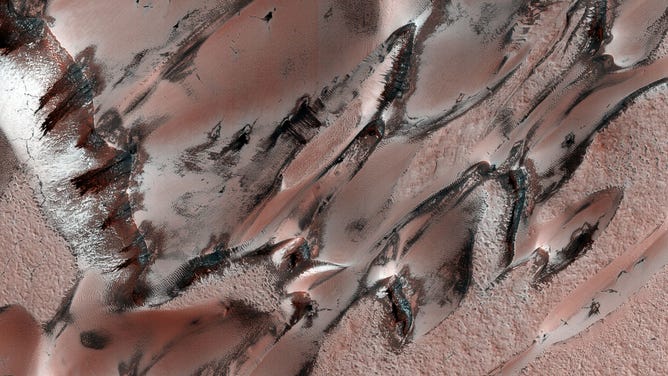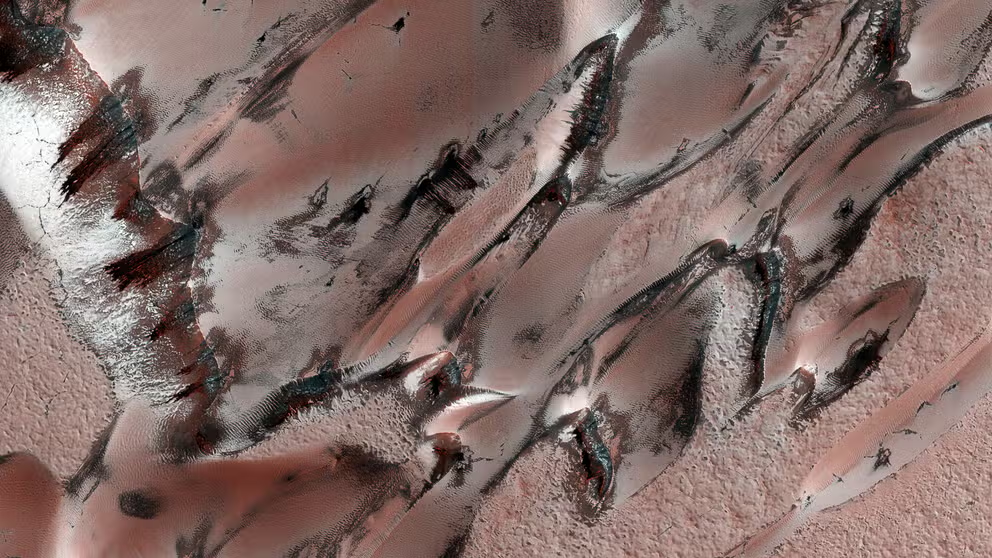Watch: Satellite photos capture snow on Mars deserts with eerie comparisons to Earth
Dunes on both planets occasionally get blanketed with ice and snow – except the white stuff on Earth is frozen water while, on Mars, it's often frozen carbon dioxide.
'Wintry' scenes from Mars: How the Red Planet sometimes looks a little white
It's not just Earth that boasts snowfall. Mars gets snow sometimes too, only there, it's frozen carbon dioxide, not water. Peek at some of the "snowy" scenes from our distant planetary neighbor.
NASA satellites have recently featured frozen precipitation in two places where you might not expect it: the desert sands of China ... and Mars. But they can bear a resemblance.
On Earth, snow-dusted dunes were spotted in China's Taklamakan Desert after a winter storm swept through the region between Jan. 12 and 14, according to NASA.
Snow is only observed in that desert every few years, last spotted in 2021, 2013 and 2008, NASA said, though such sightings may be becoming more frequent.
"One study authored by Xinjiang University researchers reported a trend toward higher temperatures and more precipitation in the Tarim Basin between 1961 and 2019, including both rain and snow," according to NASA.

The images were acquired by the Operational Land Imager-2 (OLI-2) on Landsat 9 on Jan. 19, 2023.
(NASA)
NASA'S MARS ROVER REVEALS DIVERSITY OF WILD WEATHER ON THE RED PLANET
NASA compared the photo to white-covered sandy dunes spotted just a bit farther away – OK, several million miles away – on Mars. Instruments on the Mars Reconnaissance Orbiter routinely find barchan dunes, which, at first glance, may appear to be covered in snow as well.

A group of crescent-shaped barchan dunes with a layer of carbon dioxide frost and ice that built up over the winter. The High Resolution Imaging Science Experiment (HiRISE) instrument aboard NASA’s Mars Reconnaissance Orbiter acquired the image of the dunes in the north polar region of Mars on July 28, 2021.
(JPL-Caltech / UArizona / NASA)
Yet on Mars, it's not frozen water but frozen carbon dioxide – essentially dry ice.
Carbon dioxide freezes at -190 degrees, so it only forms in areas under extremely cold conditions, such as nighttime at the poles, according to NASA. When temperatures warm, the frost doesn’t melt to liquid but instead goes straight to vapor like dry ice.
LISTEN TO A MARTIAN DUST DEVIL: THE FIRST RECORDING EVER COULD BE THE KEY TO FUTURE MISSIONS
While it's not traditional water-based snow, NASA planetary scientist Slyvian Piqueux says the Red Planet does get carbon dioxide snowfall – though usually only over flat areas with light accumulations.
"Enough falls that you could snowshoe across it," Piqueux said. "If you were looking for skiing, though, you’d have to go into a crater or cliff side, where snow could build up on a sloped surface."
IT KEEPS GOING AND GOING: NASA'S MARS HELICOPTER MAKES 40TH FLIGHT
While Mars has an average temperature of -85 degrees – enough to make you consider the sanity of snowshoeing even if the planet were inhabitable – some of the lower latitudes can reach up to 70 degrees in the summer.





